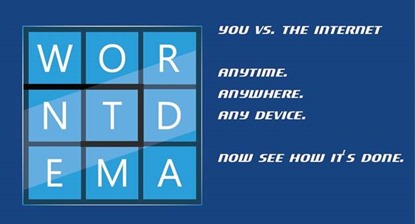Wordament and Cloud Gaming
One of the most successful word games on phones and tables is Wordament. The game is played by thousands of players, every day. It’s played on Windows phones, tablets, and PC, phones and tablets from Apple, and devices built on Android—including Kindle devices. It’s played around the world in over a dozen languages. And it’s all run on Azure.
Here are some interesting facts:
· It’s been downloaded and enjoyed by millions
· They have about 500 million game results stored
· Every puzzle is unique
· Over 7000 concurrent players have participated at a single instant in time
· After a game ends, the leaderboard for the worldwide session is shown
· During a game, everyone using the same puzzle language plays the same game for two minutes at time—everyone is connected at the same time
· The bits are located in four datacenters around the world
· They roll out a new build every night using “a ton of PowerShell scripts and TFS”
· They log everything. Data is so cheap, their data costs $45 a month
· C# is the only language used to code all parts of the game
So how does the game actually work?
1. Wordament is a game that presents a grid of 16 random, different, letters in a four by four grid. Each letter is on a tile. Each letter has a score. None of the letters are duplicates.
2. To score, you must start at a letter, and connect to an adjoining letter. You can go left, right, up, down, or diagonally. You cannot reuse the same tile.
3. The goal is to spell as many words as you can. Only words that are spelled correctly are accepted. Longer words have higher scores.
4. Every two minutes, a new game starts. Players from all over the world are playing the same game (the same four by four grid). (Different languages have their own grids and games—so people playing the English board only play against each other—not Spanish or Finnish.)
5. When the game ends, results from all players are collected, and the highest scores (and the user names of the player) are shown on the leader board.
6. After 45 seconds, the leader board disappears, and a new game begins.
7. The total playing/scoring cycle is 2 minutes and 45 seconds (165 seconds).
The Gaming Experience
One factor contributes to the success of the game: its smooth playing experience—and this is also a result of the architecture. When playing the game, new games start and stop without missing a beat, and instantly leaderboards are shown. So around the world, such as playing on a train in Africa, you can still get a reasonable response and keep playing. That feeling of effortless response is key to keeping the game going—and that is also a product of the architecture.
So what is the Architecture behind Wordament
see the following 3 part blog at https://msdn.microsoft.com/dn774975
